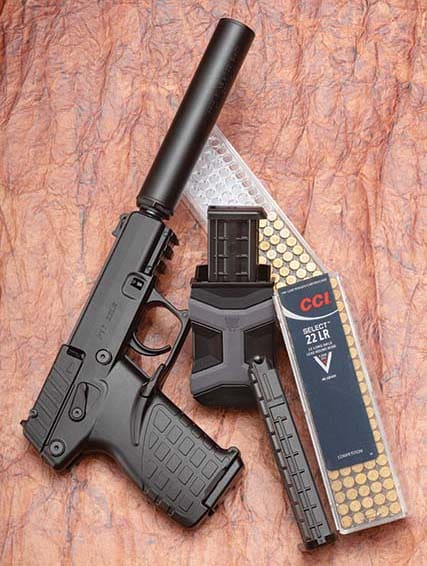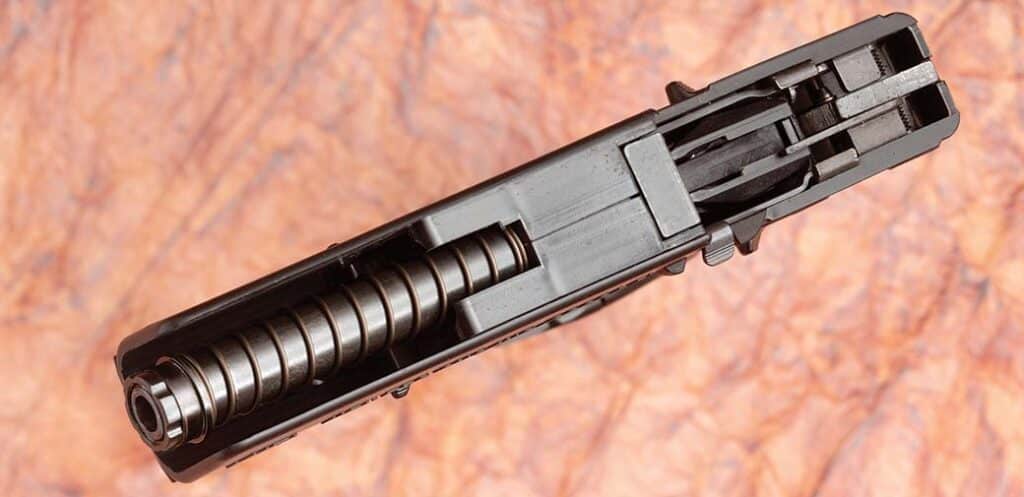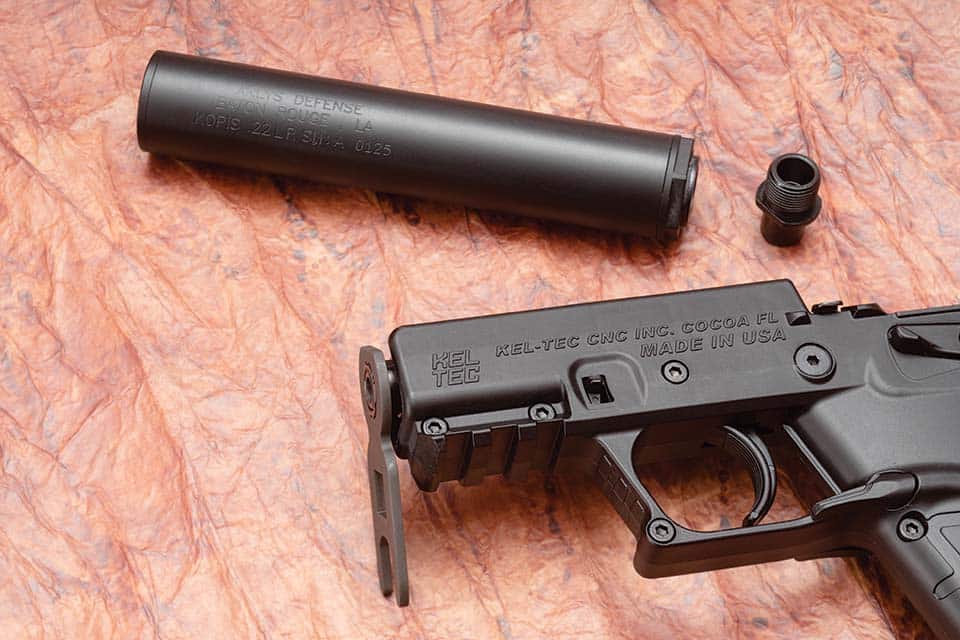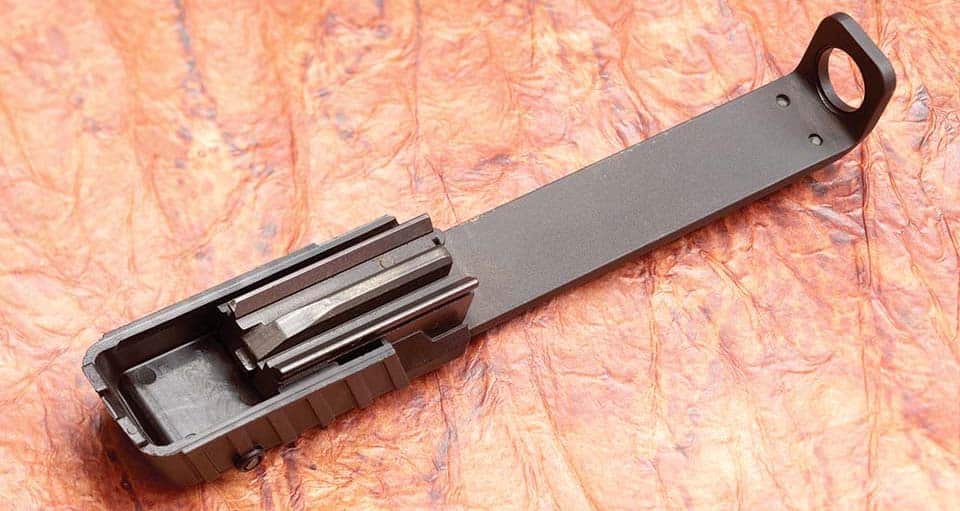By Oleg Volk
When KelTec came out last year with the CP33, the exceptionally accurate and ergonomic target pistol, the last thing I expected from the company was another rimfire pistol following on its heels. The P17, the newest firearm from the innovative Florida company, fills a completely different niche. It is far more compact, shaped more conventionally and holds 16 rounds in the magazine. P17 has no provision for mounting an optic of any kind, but it does have a threaded muzzle. In keeping with the KelTec tradition, the design is the usual steel frame contained inside a plastic clamshell. A conventional blowback hammer-fired design, it still squeezes in a couple of innovations.


Features
The slide of the pistol is a bent “L”-shaped piece of steel that covers the top of the grip-frame opening and turns into the retainer for the barrel bushing in the front. It is attached to the steel breechblock and the textured plastic cocking piece in the rear. On the sides of the barrel, where the vertical portions of the slide usually are, the grip frame continues all the way to the top of the pistol. That lightens the slide and permits very high placement for the support hand, allowing better than usual control of the weapon. The 1980s tactical grip with the support hand’s index finger wrapped around the trigger guard actually works very well with this pistol.
The magazine is the other unusual element: made entirely of plastic, it is nearly weightless but strong, thanks to extensive structural ribbing. Holding 16 cartridges, the magazine is very easy to load without a tool and proved 100% reliable during use. With the exception of two narrow slots for the bolt stop, the magazine is sealed against dust. Not burdened with a loading button attached to the follower, it fits perfectly into magazine carriers designed for centerfire mags, such as the excellent universal carrier made by Pitbull Tactical. The same carrier also accommodates GLOCK, PF9, P11, PMR30 and CP33 magazines. The magazine release is an ambidextrous paddle set into the base of the trigger guard and well-fenced against accidental activation. Three 16-round magazines are included with each pistol, extras cost under $20. The pistol does not have the unnecessary and unsafe mag disconnector which plagues so many otherwise good designs.
These technical enhancements result in a pistol weighing just over 11 ounces. In proportions, it nearly matches GLOCK 19X, a pistol which is wildly popular with consumers. Being about 1/10 inch smaller in every dimension than G19X, the P17 sits equally solidly in the hand. The ergonomics prove important, as it weighs half as much as the other gun, so every imperfection of hold would translate into greater deflection off-target. Fortunately, the ergonomics are excellent with the 3-pound trigger and without perceptible staging as a big part of it. The light trigger, with an unusually strong return spring, makes controllable rapid fire with the P17 a breeze.

Originally meant for earlier release, the P17 was delayed long enough to ensure that it is absolutely reliable with all cartridges from subsonic to hyper-velocity, with and without a sound suppressor. An extended barrel bushing threaded 1/2×28 and a wrench for it are included with the pistol. In short, running a wide variety of ammunition through the P17 had exactly zero malfunctions of any kind. Interestingly, even though the barrel is relatively thin, it does not heat up much, possibly due to forced ventilation afforded by the slide design.
The ambidextrous safety blocks the sear, so the trigger just flops with it engaged. It’s a very obvious form of feedback, immediately and obviously different from the springy feel of the live trigger. The trigger isn’t meant for target shooting, but it isn’t the limiting factor for accuracy. Neither is the barrel, but rather the sight radius. Pretty much all kinds of loads resulted in a 1.5-inch group at 10 yards, all of them showing clusters of two and three holes that resulted from inconsistent sight alignment with my eyesight. The good news is that the groups stayed almost that small on rapid fire—shooting as fast as I could come out of recoil, I ended up with about a 2-inch spread. When firing from 100 yards standing, I was able to keep about 75% of the magazine on a full-size steel silhouette. For a compact rimfire pistol, that strikes me as respectable. The key to consistency is remembering to align the top of the front sight and not the fiber optic pipe with the rear notch. The plain black rear sight is adjustable for elevation and windage with the included hex wrench.

Disassembly
Disassembly is simple in the extreme. Lock the slide back. If the threaded muzzle nut is installed, unscrew it and replace with the stock nut. Depress release latches on both sides
of the railed dust cover, pull the slide further back and lift its rear end up. Pull the front of the slide off the barrel, and that’s it! All parts of the pistol are very accessible for cleaning. Assembly and re-assembly take only seconds.

Considerations
Streamlined, lightweight and inexpensive, P17 is an ideal kit gun. The 3.8-inch barrel produces sufficient velocity to make .22LR credible for small game hunting and, in case of dire need, self-defense. 16+1 rounds of something like CCI Mini-mag dumped accurately in the span of 4 seconds or less, with a couple more magazines to back it up amounts to a credible, if not ideal deterrent, with an MSRP of $199 at time of writing. Compared to its direct competitor, the Taurus TX22, the P17 is one-third lighter and 40% less expensive.
If you want optics, KelTec’s CP33 is the way to go. If you want the iron sight radius and the balance for guaranteed 100-yard head shots rather than just highly probable torso hits, CP33 wins again. When fired suppressed, I found some unburned powder hitting my face from the open left side of the breech even with subsonic ammunition. The feeling was similar to fine sand, not painful but distracting. For silenced use, the CP33 wins, as does the TX22 with its more enclosed slide. The Taurus, however, has a different problem with suppressed use: on every sample I’ve used, the rear sight runs out of windage adjustments to zero the pistol once a can is attached. If suppressed use is important, the CP33 is the way to go. For daily carry, the P17, at less than half the weight and the price, will probably win over.
The P17 strikes me as an eminently fun pistol to shoot. It fills the hand without feeling bulky, behaves well on rapid fire and just invites burning up ammunition like there’s more at every store. It also gets the job done reliably, even with bulk ammunition. The stout firing pin imprint and well-designed feed geometry make it work well even with cheap fodder, as a proper kit gun should.
| This article first appeared in Small Arms Review V24N6 (June/July 2020) |












